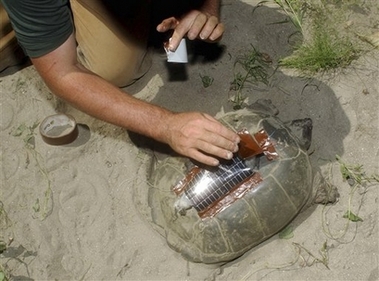Odd News
Turtles to test wireless network
(AP)
Updated: 2007-07-05 09:44
 |
Large Medium Small |
DEERFIELD, Mass. - From the way he thrashed his head, kicked and tried to make a getaway, M16 made it clear he didn't like human contact. But the researchers wrangling with him could be helping to save his species.
 University of Massachusetts biologist Mike Jones uses duct tape to secure a GPS beacon to ithe back of a 40-pound snapping turtle for research purposes on June 25, 2007 in Deerfield, Mass. [AP]  |
Using a combination of orthodontic cement and duct tape, the students attached a postcard-sized waterproof computer to the turtle's shell. After christening the 16th male turtle he found in the area as "M16," Jones scribbled some information about the turtle's shell markings into a field book and set the snapper free.
Knowing where M16 goes could help scientists protect him.
In an experiment taking place along the Deerfield River in western Massachusetts, two otherwise unrelated groups of researchers are working together: computer engineers like Garber who are testing a new wireless communication network, and biologists like Jones who are tracking snapping turtles - a species they worry may be headed for decline as land development shrinks their habitat.
The idea behind the technology is to create a network of constantly moving devices that record and store information, transmit data from one device to another, then relay all the saved information to a central location while running on self-charging batteries.
"A lot of the existing technology works great as long as you're not moving around and you have stable networks and people who could recharge batteries," said Jacob Sorber, a doctoral candidate in computer science who designed the network he calls TurtleNet, a project funded by grants from the National Science Foundation.
The solar-powered computers are light enough so they don't weigh the turtles down, and they don't interrupt their mating habits, Jones said.
Stuck to the shells of about 15 turtles found in spots near the Deerfield swamp, the gadgets will take periodic readings of the reptiles' location and body temperature.
When one computer-carrying snapper gets within a tenth-of-a-mile of another, the machines swap information.
The series of short-distance transmissions allows for long battery life in each computer, and the solar panels attached to the units are expected to constantly keep the batteries charged. Without a relay system, a longer transmission would require a larger battery that would drain too quickly or be too big for a turtle to carry.
The turtle-to-turtle relay ends when one of the snappers passes near a single base station that receives all the accumulated information. While Jones thinks the snappers may roam up to 10 miles from the Deerfield swamp they know as home, he says it's in their nature to return to the bog where the base station is.
Working like a cell phone sending a text message, the base station zaps the data to the UMass-Amherst campus about 15 miles away, where biologists are charting each turtle's whereabouts.
"We're trying to get a better idea of their range, the routes they take and where they hibernate," said Jones, who is working on a doctoral degree in biology. "If you have that information for a good number of turtles, you can predict what their patterns will be for the next 50 years or so."
Booming land development and an increase in natural predators has landed seven of Massachusetts' 10 freshwater turtle species on the state's endangered species list. Snappers aren't there yet, but Jones and other biologists are concerned they're on their way.
| 分享按钮 |